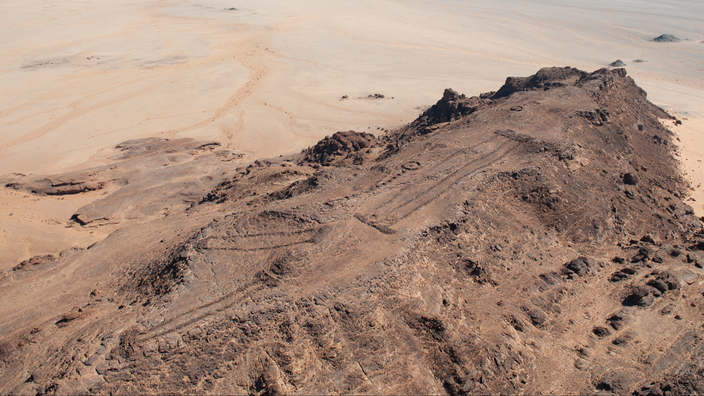Despite the apparent modesty of their hold on the ground, the many stony quadrangles scattered across northwestern Saudi Arabia are by no means ordinary.
Badly understood and until recently little studied, these thousands of monumental structures listed since the 1970s punctuate in the current region of Al-'Ula, in the province of Medina, a desert area of about 200,000 km².
Far from being mere curiosities, the concentration of these
mustalils
("
rectangles
" in Arabic), dating from the entire Neolithic period, from 6500 to 2800 BC.
AD, would attest to the presence of one of the oldest cultures to have left traces of monumental architecture.
Read also: War in Yemen: the archeology of a tragedy
Much less spectacular than an Egyptian pyramid or the fascinating megaliths of Göbekli Tepe, the discreet
mustalils
of Arabia have long
kept a
low profile before the rise of aerial photography. This revealed that they all share a fairly precise architectural form, which seems to have known little variation over several millennia. Some were over 600 meters long, these structures formed a vast elongated courtyard, bordered by a low wall of uncut stones, and framed at both ends by platforms of unequal width.
"It's very likely that larger communities or groups of people came together to build them
," explained to
The Art Newspaper.
excavation director Hugh Thomas, head of an Australian research group working on
mustalils
.
Already quite astonishing by their form, the great majority of these structures also had a small ovoid chamber made in the middle of the upper platform and accessible from the courtyard, as well as a thin passage fitted out in the lower platform, between the courtyard and the exterior of the structure.
Different
mustalils
from the Al-'Ula region.
AAKSAU and Royal Commission for AlUla)
A ritual function
"What fascinates me the most about these structures is their size, their dispersion, as well as their great uniformity"
, also underlined the archaeologist Melissa A. Kennedy, who took part in the vast prospecting campaign carried out by Hugh Thomas' Australian mission to this vast and astonishing Neolithic architectural group. According to the team of researchers who have just signed a study published in the scientific journal
Antiquity
, these prehistoric collections could have had a religious vocation. In any case, this is very strongly suggested by one of the
mustalil
excavated in 2019, whose ovoid chamber contained, around a betyle, many horns and
"cranial elements".
mostly owned by oxen, goats and gazelles.
Read also: Petra: the bewitching city of Nabataean stone
The long courtyard of the
mustalils
which makes them so recognizable could thus have served as a processional space towards the ovoid chamber, where the horns were placed as an offering. The animals, however, were not kept on site, as Australian archaeologists point out.
“The low height of the long walls (0.3-0.5 m) and the narrowness of the entrances suggest that the mustatils could not have served as enclosures for the animals
, they observe in their study.
There is also no evidence to suggest that these structures were ever covered ”
. Removing all domestic functions from
mustalils
, the researchers therefore propose to see
“The first evidence of the possible existence of a Neolithic cattle cult in northwest Arabia”
. Analyzed for carbon 14, the horns discovered date from 5300 to 5000 BC. AD, nearly two and a half millennia before the pyramids, at a time which saw the appearance of the first sedentary villages in the Near East.
These Neolithic structures, large and numerous, must have been the object of an unprecedented attention and organization for this time, believes Hugh Thomas, which
"suggests an important social organization and a common goal or belief"
, he said in his interview with
The Art Newspaper.
By extension, the hypothesis of structures with a religious vocation defended by the Australian team would also provide quite new documentary material, since it would make it possible to precisely delimit the area of influence of a prehistoric religion.
“A common religious belief could be maintained over a huge part of northwest Arabia in the Late Neolithic, a characteristic untilhere unparalleled in the world ”
, suggested Melissa A. Kennedy. If they still keep their share of mystery, the
mustalils
should however not fail to form an important stage of the tourist circuits that Saudi Arabia intends to develop in the coming years.











/cloudfront-eu-central-1.images.arcpublishing.com/prisa/KMEYMJKESBAZBE4MRBAM4TGHIQ.jpg)


